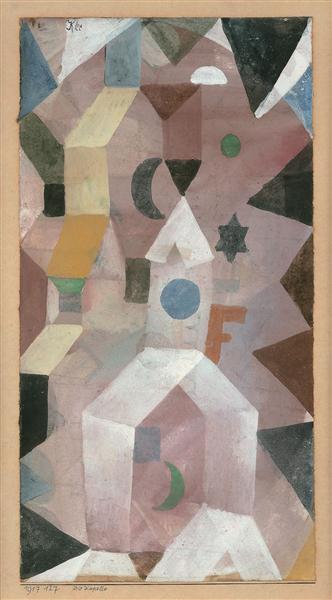Description
The chapel, painted in 1917 by Paul Klee, is a work that encapsulates the uniqueness of the artistic approach of one of the greatest exponents of expressionism and the abstract art of the twentieth century. Klee, whose work is characterized by a deep connection between shape, color and emotion, achieves in this piece not only a reflection of its stylistic experimentation, but also a meditation on spirituality and architectural space.
When observing the chapel, the viewer is immediately attracted by a vibrant and nuanced use of color. The work presents a chromatic scheme that, far from being naturalistic, seems to invoke a symbolic language. The background, in warm and terrible tones, contrasts with the central structure that evokes a chapel, painted in a colder palette. This contrast not only underlines the importance of the architectural element, but also creates a visual dialogue that invites contemplation. Klee, through his technique, uses colors that are often associated with certain emotions or moods, such as the red of the upper part, which seems to evoke a sensation of spiritual elevation.
As for the composition, the chapel is characterized by simplified geometric shapes and an almost sculptural order, which is representative of Klee's characteristic style, where abstraction merges with figurative elements. The work lacks explicit human figures, which can be interpreted as a search for the sublime in spiritual experience, instead of the individual itself. This absence of characters allows the viewer to immerse in the atmosphere of the chapel, in a space that invites introspection.
It is interesting to note that Klee's work in 1917 is in a tumultuous historical context, marked by the horrors of World War I. In this sense, the chapel can be read as a refuge for anguish and chaos of its time. Klee, who was also influenced by symbolism and child art, channels his perception of the fragility of human existence in this work, suggesting that art can provide a sanctuary, a place of peace and contemplation.
Klee, throughout his career, addressed similar issues in different works, where the connection between architecture and spirituality becomes evident. paintings Like the house of master (1921) or away from home (1921) share concern for space and its relationship with human existence. However, in the chapel, the reduction to the essential form and its emotional burden causes the work to resonate with a particular force.
Finally, it is crucial to recognize that Paul Klee, through his unique style, developed a visual language that continues to resonate in the contemporary currents of art. The chapel is a testimony of its ability to transform space and shape into a vehicle of emotional expression, providing viewers with an opportunity for reflection beyond the superficial. In this work, Klee not only creates a representation of a chapel, but establishes a bridge towards a transcendental experience that transcends any temporal or physical limit. The chapel, therefore, stands as an invitation to find beauty and meaning in the simplicity of the shape and complexity of color, elements that continue to challenge and captivate those who approach their work.
KUADROS ©, a famous paint on your wall.
Reproductions of paintings handmade oil, with the quality of professional artists and the distinctive seal of KUADROS ©.
Art reproduction service with satisfaction guarantee. If you are not completely satisfied with the replica of your painting, we refund your money 100%.

